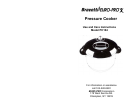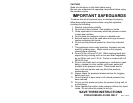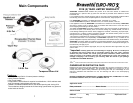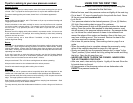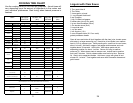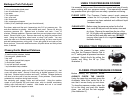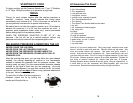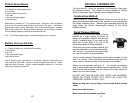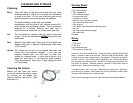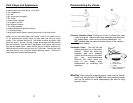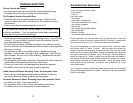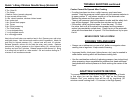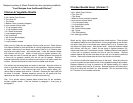
USING FOR THE FIRST TIME
Please read these instructions carefully before using the
cookware for the first time.
• Before first use, wash the pressure cooker and lightly oil the seal ring.
• Put at least 1 1/2 cups of water/liquid in the pot with the food. Never
fill the pot more than two-thirds full.
• Lock the lid.
• Turn pressure selector to the desired pressure: (I) Low, (II) Medium,
(III) High. See cooking chart on page 3 for guidance.
• Turn the heat source to high until the pressure reaches the desired
setting. Once the cooker has reached its intended pressure, a red
dot will appear in the pressure indicator window. As pressure builds
up, it is normal for a small amount of steam to be released from
around the edges of the cooker and handles. Also at this time, you
may hear a hissing sound. This is normal. Reduce the heat to the
minimum required to maintain pressure.
• Set a timer for precise timing. See cooking chart on page 3 as a
guide.
• When the cooking time is complete, release the pressure by using
either of the methods described on page 6 in this manual.
• Slowly and carefully turn the pressure selector dial “in steps” to the
“Open” position (0) and unlock the lid by pulling the handle and lifting
the lid up. Open the lid away from you.
• NEVER USE FORCE TO OPEN THE COOKER. NEVER OPEN
THE LID TOWARDS YOUR FACE.
• After use, wash, rinse and dry all parts. Lightly oil the seal. Store the
lid upside down on the pot.
• All components of the pressure cooker set are dishwasher safe
EXCEPT
the pressure cooker lid.
Tips for cooking in your new pressure cooker:
Meats & Poultry:
When adapting recipes for braised meats, allow 20 minutes cooking time per pound
of meat. Use 1 cup liquid for the first pound and ½ cup for each additional pound.
For steam-roasting poultry and meats, brown first in oil for better appearance.
Rice:
When cooking rice and grains, add 1 Tbs. butter or oil per cup to reduce foaming and
clogging the pressure valve.
Since rice doubles in size when cooked, be sure to use only half as much uncooked
rice as the cooker’s capacity allows. For example, never cook more than 1 ¾ cups
raw rice in the 3 ½ qt. pressure pan and no more than 4 cups raw rice in the 8 qt.
pressure pan.
Because rice will be slightly sticky when cooked in a pressure cooker, it is best to use
a slow release method. For example, allow cooling naturally or else slowly releasing
pressure one level at a time.
To prevent burning, use a heat diffuser if available, or bring to pressure on a
medium-high heat setting.
Beans:
Although it is not necessary to pre-soak beans for pressure-cooking, there are some
advantages. Since the gas-inducing properties of beans are water soluble, soaking
reduces their effects. Always drain the soaking water from the beans and cook with
fresh water. Soaking also cuts down the cooking time and keeps the bean skins from
separating from the flesh.
If you don’t have time to soak the beans overnight, use the Hot Soaking Method:
Use 5 cups water for every 8 oz. dried beans, pressure cook on low pressure for 3
minutes, remove from heat source and let stand 1-4 hours.
Always use at least 2 Tbs. of oil when cooking beans to reduce sputtering.
Always use the natural or slow release method to reduce pressure
.
Clean lid and vents thoroughly after cooking rice or beans.
Desserts:
Many desserts can be pressure-cooked, especially those that use eggs/and or are
cooked over a hot water bath, such as custards, bread puddings and cheesecakes.
Use a dish that easily fits inside pressure cooker allowing 1 inch of space around the
edge. The larger pressure cooker works best for this.
Seal the dish completely with foil to keep liquid from seeping into the dessert. Soak
up any moisture on top of foil before removal.
For easy removal, place dish inside steamer basket or, make a sling out of aluminum
foil.
25
2



